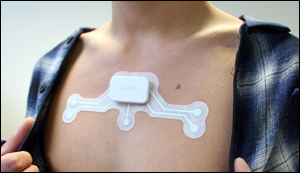Wearable Patch Uses Machine Learning to Detect Sleep Apnea
17. 2. 2020 | IEEE Spectrum | spectrum.ieee.org
Getting screened for sleep apnea often means spending a night in a special clinic hooked up to sensors that measure your brain activity, eye movement, and blood oxygen levels. But for long-term, more convenient monitoring of sleep apnea, a team of researchers has developed a wearable device that tracks a user’s breathing. The device, described in a study published 20 January in the IEEE Journal of Biomedical and Health Informatics, uses a unique combination of bioimpedance (a measurement of electrical signals passing through the body) and machine learning algorithms.
Sleep apnea is a condition whereby a person’s breathing can be disrupted as they sleep, either from physical obstruction of the throat by surrounding muscles, or when the neural signals controlling their breathing are disturbed. The condition can impair quality of life and, in some cases, lead to cardiovascular disease, memory problems, and other health complications.

In the latest advance, a group of researchers at imec and Ghent University, who had previously developed a device that measures bioimpedance, sought to explore whether the technique could also be used to monitor the breathing patterns of people with sleep apnea. Their device, called Robin, applies a small current to the body at a known frequency, and measures the resulting voltage at a different location after it passes through the body. As it turns out, Robin can be used to fairly accurately monitor a wearer’s breathing.
Read more at IEEE Spectrum
Image Credit: Onera Health Inc
-jk-




